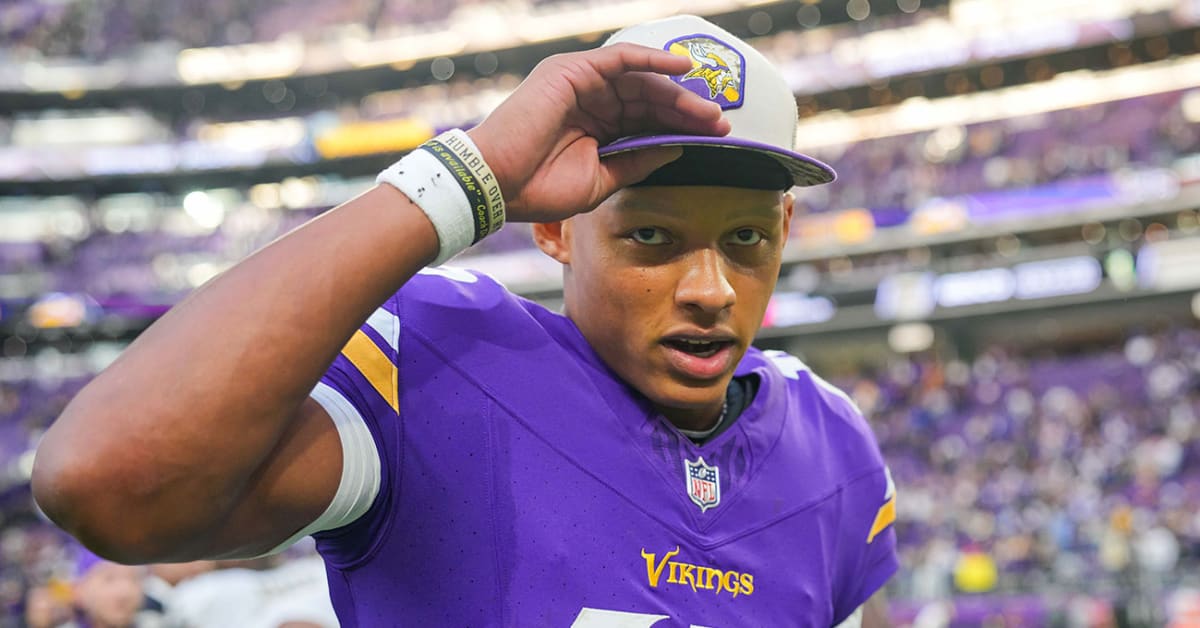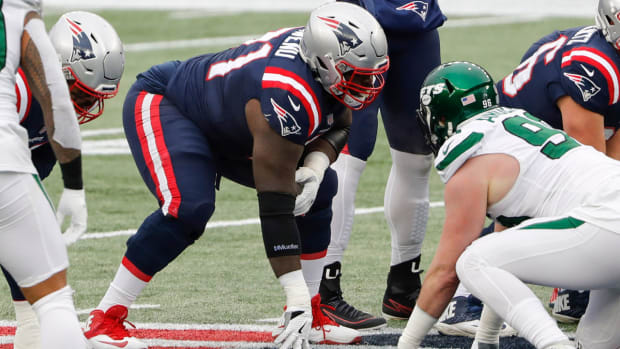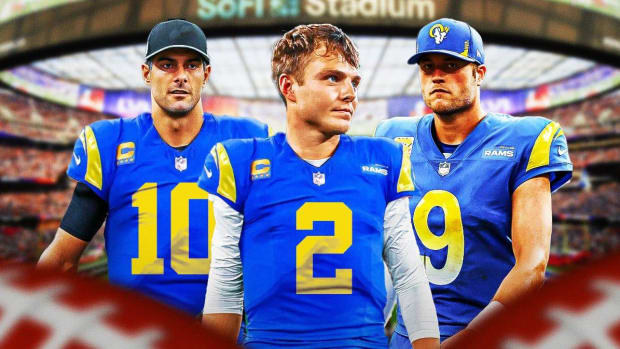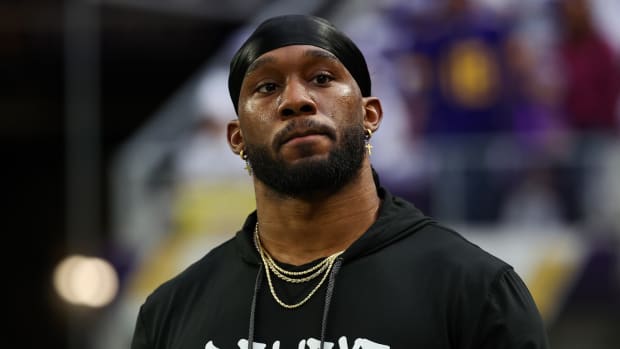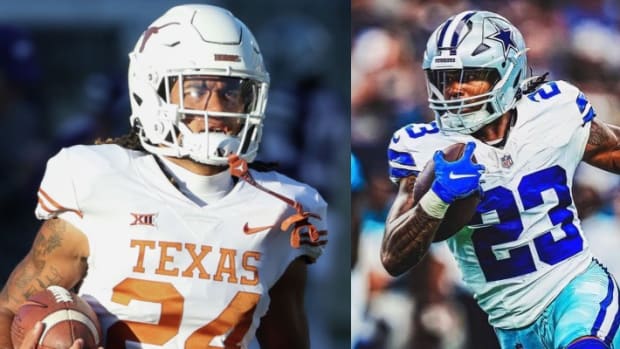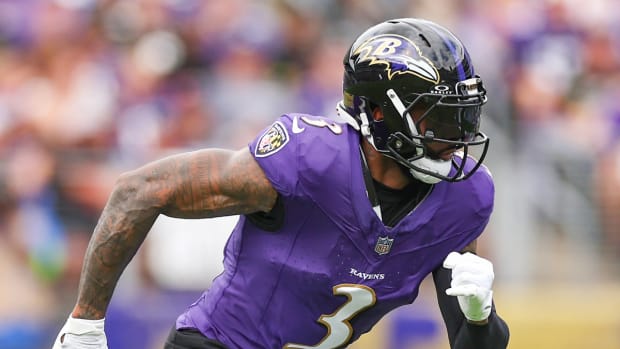Joshua Dobbs’s Former Professor Explains How Studying Rocket Science Has Benefits for a Quarterback
Perhaps you’ve heard of Joshua Dobbs, the itinerant NFL genius who hijacked the first half of this strangest of NFL seasons, in which more typical story lines have been bludgeoned by a play with “tush” in the name, an international pop star and now America’s most famous engineer. That’s Dobbs, by the way, part rocket scientist, part journeyman quarterback, part folk hero.
But rather than continue wearing thin his remarkable but oft-told, Mad Libs–style backstory, maybe a different tact works better. Which is how Matthew Mench came to conduct the strangest interview of his long and decorated career in higher education. See, while Mench is now dean of Tennessee’s Tickle College of Engineering, he’s also Dobbs’s former professor, mentor and friend. Hence why Mench is—dad joke No. 1 incoming—tickled by the improbable turn Dobbs’s career has taken this season. The attention placed a football-field-sized spotlight on the engineering programs at UT, the intensity so large and so centered, it threatened to blind not just everyone on campus but all of Knoxville or all of Tennessee; as in, the state.

Dobbs has become one of the most unlikely stories of the season as he has found success in both Arizona and Minnesota.
Brad Rempel/USA TODAY Sports
Mench pops onto a Zoom screen at 8:20 p.m. ET sharp Sunday, just in time for Sunday Night Football. Minnesota faces Denver in a matchup of middling teams that both believe they’re destined for more. Dobbs again will start at quarterback for the Vikings, the team that traded for him with the Cardinals, the deal completed only 20 days earlier, on Halloween. He’ll start in place of Kirk Cousins, whose season-ending injury set a glorious sequence of events in motion.
Dobbs’s career transactions log doubles as the NFL’s answer to War and Peace. It might be longer than the league’s voluminous rule book: drafted (Steelers; April 29, 2017), signed (May 22, 2017), traded (to the Jaguars; Sept. 9, 2019), waived (Sept. 5, 2020), claimed (Steelers; Sept. 6, 2020), signed (also the Steelers; April 19, 2021), signed (Browns; April 8, 2022), waived (Nov. 28, 2022), signed (Lions; practice squad, Dec. 5, 2022), signed (Titans; active roster, Dec. 21, 2022), signed (Browns again; March 20, 2023), traded (Cardinals; Aug. 24, 2023) and traded yet again (Vikings; Oct. 31, 2023).
In those traveling-man seasons, Dobbs was part of what seemed like every way to be transacted: drafted, demoted, added to practice squads, removed, released, signed, cut and swapped. Sometimes he’s played a lot (this season, 10 starts), sometimes not much (eight other career games, plus he didn’t get onto the field at all in 2017, ’19 or ’21). He started, backed up and backed up backups along the way. He missed games due to injury, even seasons (’19). And, when he did play, he sailed deep attempts downfield, managed games, learned new offenses, bonded with new teammates, mastered the art of checkdowns, scampered in for scores, coughed up turnovers, won and lost. He made active game-day rosters. He was inactive. This season alone, he posted four games with multiple touchdowns. This season alone, Part II: traded, yeah, twice. “Just bounced around forever,” Mench says.
The dean’s Zoom background isn’t, um, engineered (Dad joke No. 2) to impress. He appears to be set up in a guest room of sorts. But it’s hard to tell, because, behind him, the wall is blank and painted white. He laments UT’s loss to Georgia over the weekend and notes his love for college football, which started while enrolled at Penn State.
Mench is less of an NFL fan than a Joshua Dobbs fanatic. He joked with the quarterback recently about how many jerseys he owns with DOBBS stitched across the back. At least six, Mench estimates. After the Cardinals dealt Dobbs to the Vikings, the move owing to Kyler Murray’s impending return, Mench sent his guy a text message. “Man, I gotta go get another jersey,” he wrote. “I have them [from] about half the NFL at this point.” But Mench also knows how much this means to the engineer who keeps delaying his career in engineering. Hope you get a chance to play, Mench added.
Dobbs responded in typical fashion, with a joke about how he had looked up the trade-in policy for NFL jerseys and Mench was still within the three-month window to take the Cardinals version back. The funny part is he wasn’t joking. Dobbs, big-brained QB that he is, had actually done the research.
That should surprise exactly zero people who have heard of Dobbs, because, if they’ve heard of him, they know the bullet points of his backstory: aerospace engineering major, 4.0 GPA, interned for NASA. There, Dobbs joined another team, NASA’s instrumentation group, where he toiled on something known as “expiration ground systems” for the Artemis I mission, which launched in November 2022.
While engineering and professional football might seem antithetical on the surface—one, brains; the other, brawn—Mench notes that, during Dobbs’s time at Tennessee, three aspiring engineers played for the Volunteers. “The funny thing about Josh is that if you met him on the street, and you talked to him, he sounds like an engineer; he looks like an engineer, right?” Mench says, while chuckling.
His laughter stops, suddenly, at an image on the other screen nearby. An early Vikings play design was, well, poorly engineered (DJ3). For reasons known only to coach Kevin O’Connell and his offensive staff, T.J. Hockenson lined up to receive a third-down snap instead of Dobbs, who got the handoff (?), tried to scoot around the left tackle (??) and got popped (!), fumbling the ball (!!), as the Broncos recovered (?!?!).
“What the hell was that?” Mench asks, echoing football die-hards all over the world.
I joke about the Sports Illustrated jinx, which now works, apparently, in real time. Pivoting, we dive into Dobbs’s brain and how it works. Mench starts by noting that before he became the dean of Tickle, he ran the mechanical, aerospace and biomedical department; three programs, same place. One afternoon, someone from the athletic department called. They wanted him to meet with a prospect, which happens from time to time. Send him over. As they discussed aerospace engineering, and only aerospace engineering, the length of Dobbs’s nonsports passion—lifelong—became clear. Dobbs wanted to attend NASA’s space camp as much as play in a Super Bowl and may end up doing both. The discussion lasted longer than most, and then they snapped a picture.
Mench then offered a warning of sorts, telling Dobbs that his degree track would involve some math classes. He welcomed that, Dobbs responded, and there’s a snapshot of that moment, with Mench staring back at the quarterback, incredulous, framed and placed prominently in his office. That’s significant, Mench says, because Tennessee produces thousands of engineers, and this UT engineer made that kind of impression the very first time they spoke, long before Dobbs did anything of note at Neyland Stadium.
By the way, among those thousands of engineers shaped by the university in Knoxville and the subset school named after one method for inducing childhood laughter, only a handful each year would graduate with a perfect GPA. UT is one of the U.S.’s best universities for future engineers. It has placed alumni at NASA, building flight software for astronauts, designing conventional and unconventional reserves for world-class petroleum property analysis, holding lofty titles such as space shuttle main engine chief engineer; creating software/infrastructure for digital payment networks; overseeing development of military jets; becoming actual astronauts; and founding a company that overhauled health systems for the Department of Defense and the Department of Veterans Affairs. And those are just the Hall of Fame inductees since 2017, specific to the mechanical, aerospace and biomedical engineering department that Mench once ran.
Dobbs, he says, “would have been a top prospect,” and Mench means that in the academic sense, not the gridiron one. His promising future in aerospace had nothing to do with his football notoriety—and everything to do with that muscular brain, which has everything to do with why he’s still in football.

When Mench first met Dobbs, the future NFL quarterback’s passion was clear. He wanted to attend NASA’s space camp as much as play in a Super Bowl.
Courtesy of Matthew Mench
How did Dobbs make his first start at quarterback in professional football … at age 27 … only nine days after the Titans signed him … ripping him from the comfort of the Lions’ practice squad and throwing him to the lions who formed an elite defense in Tennessee? That quarterback? He engineered it!
Mench describes several relevant factors to explain. All start with Dobbs’s brain. He’s not only smart but smart with elite processing speed. He’s solution-oriented and process-driven. He’s impossible to fluster or frustrate. Mench used to marvel at Dobbs’s schedule, every minute planned and prioritized. But none of those are the real key.
What is: Engineers must solve complex problems, same as NFL quarterbacks, albeit with more time, clearer heads and less physical danger. Running an offense is engineering—as an extreme sport. Dobbs is a visual learner, meaning he can visualize in three dimensions, same as many engineers who choose design arms in that profession. They aren’t handed a math problem, per se. There’s no “equation” that must be solved. They must identify their problem, assess the tools they have available and hunt for a solution to the problem they alone identified. Given the complexity involved, the ability to think three-dimensionally becomes a major advantage. Those engineers don’t have to fashion or wait for models that are built based on what’s already in their heads.
With NFL quarterbacks, evaluators often point to “spatial awareness,” and Dobbs deploys the same approach grounded in visual learning to pick up offensive schemes, which are like new languages, faster than seems humanly possible. “It’s impossible,” Mench says, meaning that it should be. But not for Dobbs, who combines intellect, learning style, approach, work ethic, demeanor, social maturity and emotional maturity with actual athletic gifts.
The combination doesn’t necessarily make him the best quarterback in the NFL. But it does make him the fastest study, which makes him, despite all the stops, more valuable to franchises than might be obvious. The phrase plug-and-play from the NFL’s jargon handbook very rarely applies to quarterbacks, and yet, it obviously and prominently applies to Dobbs.
Dobbs’s Vikings tenure, all two weeks and five days of it before the Denver game, is more irrefutable proof. Cousins tore an Achilles on Oct. 29. The Vikings traded for Dobbs two days later. O’Connell started Jaren Hall on Nov. 5 against the Falcons, but Hall was injured (concussion) in the first quarter. Imagine being Dobbs right then. In town for all of five days. Staying in a hotel adjacent to team headquarters. Dealt for a measly late-round pick swap. Entrusted with saving no less than a contender’s promising season. After said contender stumbled through the first half, eliminating all the promise. Time to prepare not just finite but severely limited and finite. Haven’t met some teammates. Couldn’t sleep the first night, due to time zone differences, which meant Day 1 started with a tired brain. Missed the first offensive meeting to take physical. Only reps at practice were mental. Number of practice passes thrown: zero. Suited up, anyway. Received a tutorial … after the injury … before jogging onto the field … wearing a different uniform … playing in a vastly different scheme … with only a week between games. Would you even try, risking embarrassment on national television, not to mention personal health?
Dobbs would—Dobbs did—and on his very first day in a Vikings uniform, he soon moved the offense downfield, deliberately, 11 plays that doubled as proof of concept and culminated in another touchdown thrown for another franchise. That drive followed a safety and a fumble that marred his first two possessions as a Viking, reinforcing Dobbs’s brain as lightning-cable fast. After seven plays—seven!—in a new and confusing and nobody-feels-sorry-for-ya crucible, he led the drive of a career and salvaged the Vikings’ already dimmed playoff hopes.
That afternoon, Dobbs became only the second QB in league history to start for three separate franchises in the same calendar year. He was the first to do that after fewer than three weeks with each team before he started, which makes him the answer to one of the NFL’s strangest future trivia questions, an overnight sensation who hadn’t done anything overnight except master new languages in football.
The next week, at home against the Saints, with another six days of preparation, Dobbs completed two-thirds of his pass attempts while throwing for 268 yards and a touchdown. He not only lifted Minnesota to another win; he vaulted the franchise back into NFC North contention.

The ability Dobbs has to tackle complicated engineering problems has served him well on the football field.
Courtesy of Matthew Mench
After the disastrous play against the Broncos, Dobbs, well, engineers another drive at the end of the first quarter. On the first play of the second, he finds tight end Josh Oliver in the right flat for another score. This sequence reminds Mench of a favorite moment from their time together, from Dobbs’s junior season in 2016, when wildfires devastated nearby Gatlinburg and Dobbs drove, by himself, to visit a temporary shelter set up for victims. Dobbs didn’t do this for fanfare or followers on social media. He did this because he considered the gesture the right thing to do and nothing more.
“That’s part of this,” Mench says. “He’s calm. He’s collected. He puts in so, so much. That will add up over time.”
Or, in the case of Sunday, over games. Dobbs moves the Vikings’s offense downfield on another drive in the second quarter, netting a field goal and a 10–9 lead at halftime of a nationally televised affair played in the thinnest of air. The circumstances could not have been more difficult. But in Dobbs, Mench sees someone “who’s at his best when he thinks he’s destined to do that thing.”
He cites another example: Early into childhood, Dobbs became aware of a milestone his mother, Stephanie, reached. Through high school, she had perfect attendance. This, Joshua decided, was also his destiny. And he also reached perfect attendance, even if it meant delaying recruiting visits or missing them altogether.
After one Dobbs scramble, that nets another touchdown on Minnesota’s first second-half possession, a sacrilegious question must be posed. Because of the scramble, the jersey number (15) and the improvisational nature of his play, doesn’t Dobbs recall, even vaguely, Patrick Mahomes?
Mench doesn’t disagree, as another story surfaces from the pylon Dobbs collides with as he scores. Dobbs created his own tradition at Tennessee. He would take pylons as souvenirs after games. “I don’t know if he still does this in the NFL,” Mench says. “But, really, seriously, he has a room full of pylons.”
Of course, Dobbs’s tradition centered on the rare structure within the boundaries of a football field.
Still, missions can go awry, even for the rocket scientists among us. This happens against the Broncos and on consecutive possessions—an Alexander Mattison fumble ends another drive already in field goal range, and Dobbs throws his first interception for Minnesota. Denver kicks field goals after both turnovers, trimming the Vikings’ lead to 17–15 and creating an opening for the first Houston-we-have-a-problem reference in an NFL game that doesn’t involve the Texans.
Mench happily heads down a rabbit hole I’ve introduced, centered on similarities between football and engineering. I’m arguing that we’re early into football’s Nerd era, in which big brains are valued more than big muscles, because what matters in the modern NFL are fractions of seconds. Players are too fast, and decisions must be made too quickly for anything else to matter more. The Kyle Shanahan coaching tree is responsible for this shift, for speeding up the game and valuing precision and thinkers and deception born from both. Even the members of that tree who marry Instagram models (Sean McVay) rank among football’s biggest nerds. They’re making the NFL more like the NBA, more positionless, more creative. Even their schemes are simplified, with fewer overall plays, and charged with complexity, from so many variations available for each one. How teams defend them becomes data to input and counter and counter off counters. The next step—only sort of joking here—is someone naming a supercomputer designed specifically to dominate pro football as an assistant head coach.
So … did the NFL, in some ways, evolve toward Dobbs?
“Maybe,” Mench says. Could be the happiest of coincidences, this path, where the league becomes smarter and more complicated and Dobbs digs in, stubborn and destined, and two evolutions happen to meet in the same league at the same time. Regardless, it’s now obvious that Dobbs, in 2023 specifically, has never fit better in the NFL. Some of that owes to the Vikings and their roster and his teammates. But Dobbs has done all this in three weeks, without Justin Jefferson, who’s only (arguably) the best wideout in the league. “Teams see there’s real value in [Dobbs],” Mench says.
Another story! As an honorary Tennessee assistant one summer, Mench spent a week embedded with the Volunteers’ program. The quarterback room most reminded him of an advanced engineering class, even if he didn’t understand this particular foreign language. He watched Dobbs absorb the information for that week, memorize it and spit it back in a matter of minutes. The backup needed longer but also completed the task that day. What stood out, though, was the freshman signal-caller, whom Mench spied at the end of a meeting looking despondent, head down and face covered by hands.
The fourth quarter Sunday swings back and forth. Dobbs and the Vikings net another field goal. But the Broncos fashion their best drive, score and regain the lead for the first time since 3–0 with only 1:03 left. Mench can’t be the only Volunteers obsessive who thinks of the same game, same play, even, from the 2016 season—the Hail Mary to Jauan Jennings that upended Georgia in what has become a one-sided rivalry with Tennessee. The UT engineering school put a framed picture—signed by Dobbs—in its box at Neyland Stadium.
Point being, don’t ever count Dobbs out. While Mench mentions that the Dobbs family still sends him its annual Christmas card (funny, but he cannot recall one that featured Josh’s picture on the front!)the quarterback cannot get the Vikings’ offense moving. This drive starts on their own 25. The last snap—an incompletion—starts on their 21.
Soon, Dobbs will become an engineer, at least after what he hopes will be a much longer delay. He’ll become an entry-level engineer, Mench says, no worse for his football ambitions but with plenty to relearn and a few years of “hardcore engineering” ahead. Mench wonders whether Dobbs will even choose that path. His interests seem broader, after all, and he’d make for an elite offensive coordinator who engineers touchdowns rather than space shuttle systems. Perhaps all the attention paid to Dobbs in football makes him appealing to NASA or a similar organization in a more public-facing role.
For now, Mench says Dobbs has risen to the third-most-popular person in both the city of Knoxville and the state of Tennessee. “Right now, it’s Dolly Parton, Peyton Manning and then Josh,” Mench says.
Dobbs will, undoubtedly, continue to bolster interest in not just Tennessee’s football program but also its engineering one. He’ll continue to make the dean who once advised him a little bit more football famous every week.
Mench cannot outright dismiss the possibility that Dobbs might end up in space one day, or on a team that helps send others there, or part of a group that improves the experience of anyone who goes there, whether astronauts, billionaires or otherwise. Not likely. Possible.
Then there’s the duality involved. Is Dobbs the best engineer to ever play pro football? The best combination of both disciplines? He might be. But he might not even be that at his alma mater?
Funny enough, Mench says, Dobbs took most of his classes inside a building named to honor Nathan W. Dougherty, the longtime engineering dean and the chairman of the university’s athletic counsel. Many consider Dougherty the founding father of major college sports at Tennessee. At least Dobbs made the NFL, you might say. But Dougherty, an offensive guard, made college football halls of fame before the NFL existed in anything like its current form.
Who’s better? Who cares? If they’ve proved anything at Tennessee, it’s that their football-playing engineers will figure out some sort of solution. Of course. They will engineer it.
































